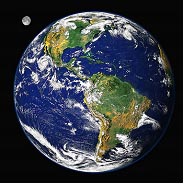Apr 13, 2025
Apr 13, 2025
 Introduction & Overview
Introduction & Overview
"Pressures resulting from unrestrained population growth put demands on the natural world that can overwhelm any efforts to achieve a sustainable future. If we are to halt the destruction of our environment, we must accept limits to that growth." - World Scientists' Warning to Humanity, November 18, 1992 (Signed by 1600 senior scientists from 70 countries, including 102 Nobel Prize laureates)
"It is not prudent to rely on science and technology alone to solve problems created by rapid population growth, wasteful resource consumption and harmful human practices." - U.S. National Academy of Sciences and Royal Society of London, Joint Statement, 1992
"Prudent and increasingly reliable estimates suggest that the Earth's long-term sustainable human carrying capacity, at what might be defined as an adequate to moderately comfortable developed-world standard of living, may not be much greater than 2-3 billion - It is increasingly apparent that the long-term sustainability of civilization will require not just a leveling-off of human numbers as projected over the coming half-century, but a colossal reduction in both population and consumption". - J. Kenneth Smail, Professor Emeritus of Anthropology, Kenyon College
Scientists currently use a 'consumption footprint' (expressed in acres or hectares) to help citizens understand their impact upon the biosphere. However, to reflect one's impact and decisions more comprehensively, we need to use the Decision Footprint, which is a function of four areas: a person's consumption 'decisions', the number of children one 'decides' to create, the country one 'decides' to adopt children from, and one's 'decisions' to enhance our life-support system. For the purpose of this essay, we will use the following factors to quantify the above areas:
(1) Consumption-decision Factor,
(2) Child-creation Factor,
(3) Adoption Factor, and
(4) Life-support Protection Factor.
Because it is based on one's decisions and a more comprehensive footprint, the Decision Footprint will provide a much-needed incentive to reduce our population as well as our consumption. Furthermore, many citizens look at their consumption rate and think: What's the point of even trying? The Decision Footprint will help them to overcome this despair by placing responsibility where it belongs and rewarding people for making decisions that restore our life-support system. The following paragraphs will expand on the four factors and how they are calculated.
How to Calculate the Factors
Consumption-decision Factor
 First, determine the 'average' consumption footprint or rate for one's country using the Global Footprint Network'for the U.S. it's 23.5 acres.1 Since a person does not make the decision to be created or where they are born, this average will be the starting point for one's Consumption-decision Factor. If a person remains at the average for the country they live in, the factor will be zero. If one consumes more, it will be a plus. If one consumes less, it will be a minus or a negative number. Of course, in poor countries, the average will need to be adjusted to reflect a minimum quality-of-life standard and in wealthy countries one may want to make an adjustment as well (these issues are discussed in greater detail later). One can calculate their 'personal' consumption footprint or rate using the calculator provided by Redefining Progress (www.myfootprint.org) and subsequently determine their Consumption-decision Factor. Another personal consumption calculator, with slightly different questions, is provided atwww.mec.ca/Apps/ecoCalc/ecoCalc.jsp (be careful to select metrics or American as the desired measurement system prior to taking the test).2 Because of these differences and how one may interpret and answer each question, it's recommended that the reader accomplish both calculations and use the lower of the two figures to determine one's personal consumption rate. So if a U.S. citizen had a personal consumption rate of 33.5, their Consumption-decision Factor would be calculated as 33.5 minus 23.5 or 10 acres. On the other hand, if their personal consumption rate were 13.5, their Consumption-decision factor would be 13.5 minus 23.5 or a 'negative' 10 acres.
First, determine the 'average' consumption footprint or rate for one's country using the Global Footprint Network'for the U.S. it's 23.5 acres.1 Since a person does not make the decision to be created or where they are born, this average will be the starting point for one's Consumption-decision Factor. If a person remains at the average for the country they live in, the factor will be zero. If one consumes more, it will be a plus. If one consumes less, it will be a minus or a negative number. Of course, in poor countries, the average will need to be adjusted to reflect a minimum quality-of-life standard and in wealthy countries one may want to make an adjustment as well (these issues are discussed in greater detail later). One can calculate their 'personal' consumption footprint or rate using the calculator provided by Redefining Progress (www.myfootprint.org) and subsequently determine their Consumption-decision Factor. Another personal consumption calculator, with slightly different questions, is provided atwww.mec.ca/Apps/ecoCalc/ecoCalc.jsp (be careful to select metrics or American as the desired measurement system prior to taking the test).2 Because of these differences and how one may interpret and answer each question, it's recommended that the reader accomplish both calculations and use the lower of the two figures to determine one's personal consumption rate. So if a U.S. citizen had a personal consumption rate of 33.5, their Consumption-decision Factor would be calculated as 33.5 minus 23.5 or 10 acres. On the other hand, if their personal consumption rate were 13.5, their Consumption-decision factor would be 13.5 minus 23.5 or a 'negative' 10 acres.
Child-creation Factor
 This factor is applied where a couple or individual has made the decision to create a child. This decision can be the traditional method or by using the many methods associated with fertility clinics and donor material. Since it's impossible to determine the future consumption rate of a child, we will use the average rate for the country where a child is living as the Child-creation Factor (an adjustment is made for poor countries and explained later in the essay). In the U.S., the average consumption rate is 23.5 acres.3 Unfortunately, in areas of the world where contraceptive services, educational opportunities, and social security are difficult to obtain, citizens have far less freedom to address this factor and much work needs to be done to solve this issue'freedom many citizens in wealthy countries take for granted. In addition, many cultures and families (even in progressive countries) are still male dominated'restricting the freedom of women.
This factor is applied where a couple or individual has made the decision to create a child. This decision can be the traditional method or by using the many methods associated with fertility clinics and donor material. Since it's impossible to determine the future consumption rate of a child, we will use the average rate for the country where a child is living as the Child-creation Factor (an adjustment is made for poor countries and explained later in the essay). In the U.S., the average consumption rate is 23.5 acres.3 Unfortunately, in areas of the world where contraceptive services, educational opportunities, and social security are difficult to obtain, citizens have far less freedom to address this factor and much work needs to be done to solve this issue'freedom many citizens in wealthy countries take for granted. In addition, many cultures and families (even in progressive countries) are still male dominated'restricting the freedom of women.
Adoption Factor
If one adopts a child from within their country, the factor remains neutral. However, if one decides to adopt a child from outside their country the 'difference' between the two countries' average-consumption rates is used to establish the factor. So bringing a child from a country with a modest-consumption rate into a country with a high-consumption rate is reflected and vice versa. However, it's important not to unfairly penalize children from poor countries. Therefore, if the average consumption rate of a country is less than 12.6 acres, which is the average consumption rate for Western Europe, the 12.6 figure is used instead of the actual.4 Why use Western Europe as a standard? Because it's reasonable to argue that Western Europe provides a comfortable and rewarding life to its citizens at a lower consumption rate than others'a quality of life and consumption rate many citizens, living in rich or poor countries, would select if they had the option.
Furthermore, given human history, it's difficult to believe that the vast majority of humanity would voluntarily consume at a level lower than 12.6 acres (given humanity's current technology selection and use). Of course, society should strive to lower this rate as much as possible while maintaining an acceptable quality of life, but this will take time and new thinking. Therefore, if an American couple adopts a child from a country with an average consumption rate equal to or lower than 12.6, the Adoption Factor would be calculated as 23.5 (the average U.S. consumption rate) minus the 12.6, giving us an Adoption Factor of 10.9 acres. If an American couple adopted a Swiss child, the Adoption Factor would be 23.5 minus 13.1 (the average consumption rate for Switzerland), resulting in an Adoption Factor of 10.4 acres.5 However, if a Swiss couple adopted an American child, their Adoption Factor would be 13.1 minus 23.5, giving them an Adoption Factor of a 'negative' 10.4 acres.
Life-support Protection Factor
This is the number of acres one protects for wildlife habitat using their purchasing power and/or time. This factor should not be viewed as a method to offset any future Child-creation Factors or to justify increased consumption. On a finite and overstressed planet, creating additional children and increasing consumption will only make the Life-support Protection Factor more difficult to maintain as an option for everyone. This factor should be viewed as a method of helping to restore our life-support system from past decisions and the decisions of past generations'a gift to humanity's future.
The Life-support Protection Factor is a function of many things and can be difficult to measure. Therefore, it's an issue for the conscience of each person calculating his or her Decision Footprint. In most cases it will be a small figure, perhaps one or two acres for belonging to environmental or conservation groups (a few hundred or even a few thousand dollars worth of time, membership fees, hunting and fishing licenses, and donations can only go so far every year, even with the synergistic effect taken into account).
Nevertheless, this factor can be significant for some people'especially people who sacrifice deeply and use or donate large sums of money to purchase and protect land for biodiversity protection and/or restoration. This is not the same as maintaining human-use land (such as farmland, large yards, tree farms, etc.). To obtain an acre-for-acre credit, one needs to preserve the land to maximize native biodiversity and the health of our life-support system. However, one could take partial credit for improving human-use land for native species and diversity. Again, the Life-support Protection Factor can be difficult to measure and in most cases would be small. Of course, the reader is encouraged to reflect upon and increase this factor as much as possible. Simplifying one's lifestyle and using or donating the money saved to purchase land is a powerful method to achieve this goal. Such action will also decrease one's Consumption-decision Factor'having a multiplying effect upon their Decision Footprint.
continued
02-Apr-2006
More by : William C. Gladish